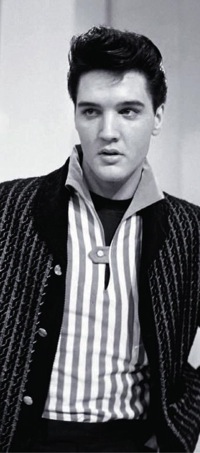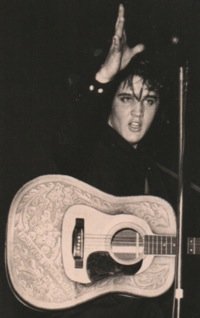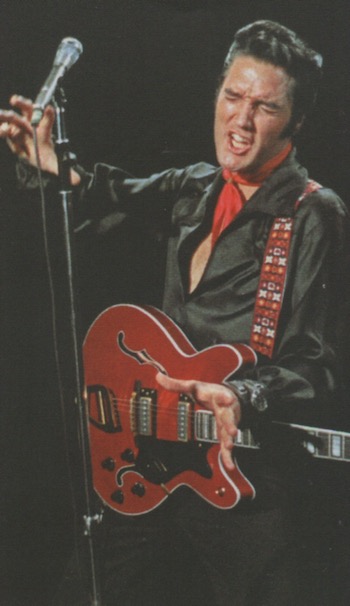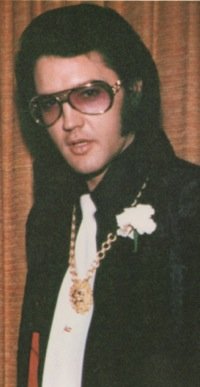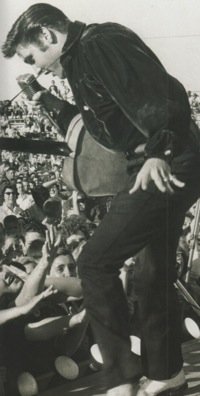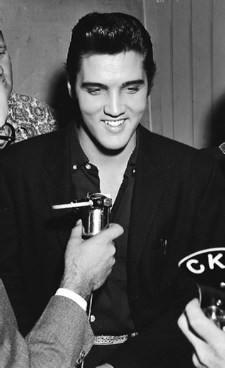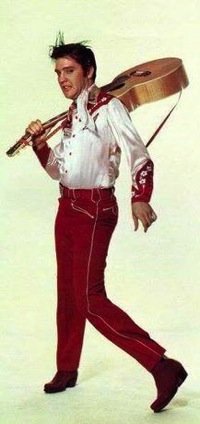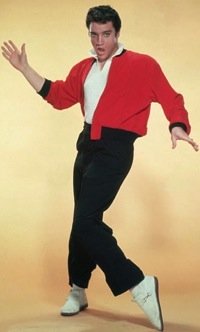Elvis History Blog
Eggheads on Elvis
Professorial Opinions in the ’50s
It the 1950s the battle over Elvis Presley was fought out mainly in the press and the pulpit. From their preeminent venues, columnists and clergymen spewed forth their opinions, predominantly negative, of Presley and rock ’n’ roll. The singer’s faithful followers, principally the 14- to 16-year-old female demographic, struck back by flooding the newspapers’ letters-to-the-editor columns with declarations of support.
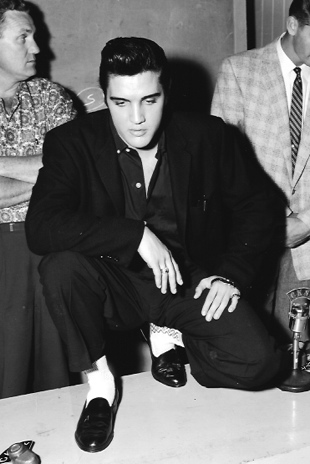
In general the inhabitants of the nation’s institutions of higher learning remained above the fray. College students of the day, generally sporting conservative views and conservative tastes in music, looked down on Elvis. It was a group of Philadelphia college boys, after all, who egged the stage when Presley appeared in their town in 1957.
Speaking of eggs, what did the nation’s college professors think of Elvis in the fifties? It’s doubtful Elvis was the subject of much profound academic discussion at the time of his initial rise to fame. The simplicity and nonsensical nature of rock ’n’ roll music and its popular leader were simply not worth serious scholarly consideration. Occasionally, though, the learned thoughts of college professors made their way into the nation’s press. Following are summaries of six published academic analyses of Elvis Presley from 1956 and 1957.
• Professor Wood, Art Department Head, Arizona State College
The Boston Post didn’t include a first name when detailing on the professor’s opinion of Elvis in its October 2, 1956, issue. The paper reported that Professor Wood had said that Elvis and Praxiteles’ statue of Hermes were look-alikes. The same went for the statue of Theseus on the Parthenon at Athens. Wood declared Presley and the statues had the same nose, same lips, and same sideburns. The professor went further, asserting that Elvis’s bumps and grinds were typical of the twitch and twist of Greek sculpture.
A skeptical Post editorial writer lectured Professor Wood in turn. “Come, come, professor, lecture courses on Greek art can’t be that hard up! Elvis Presley has about as much resemblance to Praxiteles’ Hermes as you have to a Martian. Of course, if the bone-shaking singer’s press agent is even half awake he will haul his client off to some museum, pose him beside a plaster cast of Praxiteles’ Hermes, while Presley sings to the statue, ‘You Ain’t Nothing But a Houn’ Dog.’ Ah, this culture bit! Even the squares get into the act.”
• Professor Marshall McLuhan, PhD, St. Michael’s College, Vermont
The Toronto Telegram reported that Professor McLuhan came out in support of Elvis Presley during an appearance on CFRB-TV’s “Youth in Action” broadcast of March 31, 1957. “Elvis Presley does a lot of good,” asserted the professor. “He brings millions of people together with a common interest. He is sophisticated, ironical and does his work with tongue in cheek.” The teenaged studio audience cheered his assessment.
Professor McLuhan declared that rock ’n’ roll was a definite form of culture, although he discreetly avoided providing details. He also admitted that he had never seen Presley in action.
• Professor Archie N. Jones, Music Department, University of Texas
“There’s nothing wrong with rock ’n’ roll music itself,” Professor Jones explained. “It’s the beer hall atmosphere and some of the people associated with rock ’n’ roll that is objectionable.” Variety reported on an interview Jones gave in Austin, Texas, on April 30, 1957.
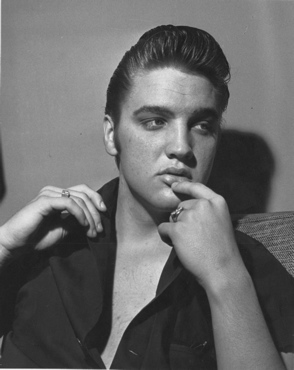
“It is impossible for any type of music to be immoral,” Jones declared. “The immorality of the question comes in only when people are involved.” He said he personally found objectionable some rock ’n’ roll performances that were not done in good taste, and he singled out Elvis as an example. “It might well be possible,” he said, “that some other performer might take the same songs that Elvis Presley sings and do them well.”
Dr. Jones went on to say that rock ’n’ roll was of no importance. “It is only another part of the cycle of ‘fadism’ which has been with us for the last 30 years … I doubt that rock ’n’ roll will be anything but a memory as a name.”
• Dr. David H. Webster, English professor, Temple University
Professor Webster’s homecoming address, entitled “Elvis Presley and Shakespeare,” was the subject of an article in Variety on October 31, 1956. Dr. Webster pompously revealed the secret of Elvis Presley’s appeal to young people. “The music of Presley emphasizes exhaustion, self-torture, frustration and always a rhythm of sullen, ugly complaint," he declared.
He defended the rise of jazz in the 1920s for its vitality, exuberance and hearty enjoyment of life. However, there was only danger and degradation in rock ’n’ roll, he asserted. “Presley’s popularity is more serious than we think. We should examine more closely those forces in our civilization which make so many of our young people respond so quickly to the self-pity and the hatred that beat through this music.”
• Dr. S. D. Clark, professor of sociology, University of Toronto
Professor Clark’s long column on Elvis Presley and rock ’n’ roll music appeared in the Toronto Daily Star on April 3, 1957, the day after Presley’s first Canadian appearance in the city. Clark was dismissive of the show from the start. “Anyone observing the Elvis Presley show at the Maple Leaf Gardens last evening might well conclude that the whole thing was a phony. The build-up on the stage was clearly intended to secure a certain kind of audience reaction, and the audience, like a well-trained cast, reacted as it was expected to. It was a noisy show but the noise was part of the act. There was no great stirring of emotions.”
And because the show was “phony,” Dr. Clark concluded that it was harmless as well. “If there was any appeal to the baser passions, it was largely lost on the audience,” he noted. “We have produced a tough generation of youngsters who can more than take Elvis Presley in their stride and be none the worse for it. In terms, therefore, of the psychological or moral welfare of our young people, the show in the Gardens last night offers no reason for concern. It is easy to shout that the youth of today is going to the bad, but it was a decent lot of kids who went out in such numbers to have a look at Presley.”
While Professor Clark saw no moral danger in Presley’s show, he did see in it a reason for future economic concern. “In our society we do not put our young people to work at the age when they become physically men and women. We keep them long after that in school, enjoying much of the freedom of adults but accepting few of the adults’ responsibilities.”
He contended also that Elvis’ audience was a product of the sudden rise in the birthrate following World War II. “It was the war babies who flocked to see Elvis Presley last night!” Dr. Clark asserted, even though by 1957 the oldest of the “baby boomers” were still in elementary school.
In conclusion, though, Clark did give Elvis some credit for the hysteria he created in Toronto. “It would be foolish, of course, to suggest that it is this failure of society to impose on young people the responsibilities of adulthood which alone accounts for the Elvis Presley rages of our time. The techniques employed by Presley were much like the techniques employed by the high-powered evangelist, and the results were much the same.”
• Dr. Ray L. Birdwhistell, professor of anthropology, University of Buffalo
“The pelvic contortions of Elvis Aaron Presley have become the subject of a sober, but satisfying study.” That was the lead in a Buffalo Courier-Express article of April 3, 1957. It described Dr. Birdwhistell, conductor of the study, as an expert on kinesics, the study of body gestures and what they mean. He had found in Presley a “fascinating subject of anthropological speculations.”
His findings were still inconclusive, he said, after watching Elvis perform in Buffalo on April 1, 1957. “It’s just a joyful ritual, amazingly innocent and perfectly harmless,” he observed of Presley’s effect on his young fans. Leaving the singer’s distinctive vocalizing to other experts, Birdwhistell explained he was only interested in Presley’s motions. He contended Elvis’ gyrations were “not sexy but only a caricature of sex.”
The professor added, “Presley joins his audience in making fun of adult emotions. His appearance and gestures are overstatements of the young adolescent’s mocking attitude against the adult.” Although Dr. Birdwhistell agreed that his subject often swung his hips and flaunted his pelvis, he insisted it was nothing to raise concern among psychologists or parents. “What you have is an amazingly skilled entertainer,” he explained, “an excellent showman with a high response rate to the audience reactions. He plays back to the audience. You never had a performer-versus-spectator situation.”
It seems, then, that even the intellectual crowd in the fifties was at odds with itself when it came to Elvis Presley. The eggheads might have been better able to express their opinions about Elvis and the changes he was helping make in American culture. Still, they could come to no consensus in their judgment concerning his capacity for spreading good or evil across the cultural landscape. As a group, the nation’s academics were no more successful in figuring out Elvis Presley than were the preachers, the parents, or the press. — Alan Hanson | © November 2011
Go to Elvis History
Go to Home Page
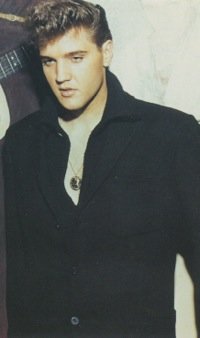
“Presley joins his audience in making fun of adult emotions. His appearance and gestures are overstatements of the young adolescent’s mocking attitude against the adult.”
